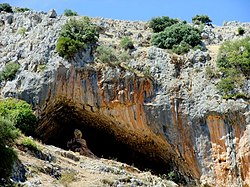Cueva de los Murciélagos
| Cueva de los Murciélagos | |
|---|---|
 | |
| Location | Zuheros, Andalusia, Spain |
| Coordinates | 37°32′31″N 4°18′15″W / 37.54194°N 4.30417°W |
| Length | 2,000 m |
| Discovery | 1868 |
| Geology | Dripstone cave |
The Cueva de los Murciélagos is a cave system in the Sierras Subbéticas located about 4 km southeast of the town of Zuheros in the southern province of Córdoba in Spain. Although the caves were discovered in 1868, they were not studied until 1938. The caves host one of the largest bat colonies in Andalusia.[1]
Location and formation
[edit]The caves are located in an extensive karst landscape at an altitude of 980 metres in the heart of the Cañada de Malos Vientos mountain (1000 m) in southern Andalusia. The rock formations and caves with stalactites, stalagmites and subterranean lakes were formed due to weathering and leaching of carbonate rocks. The caves have a total length of 2,000 metres, of which only 450 metres can be accessed.[1]
History
[edit]Speleologists discovered tombs from the middle Paleolithic period, which show evidence of human occupation of the caves 35,000 years ago. According to the Carbon-14 dating method, finds from the Neolithic period have an age from 4,900[2] to 3,980 BC. In 2023 the redating of baskets and shoes suggested that the age of the items was approximately 9,500 years old.[3][4]
The researchers reconstructed the lives of people whose artefacts were found preferentially at the cave entrance. Here they cooked their meals on an open firepit. Their diet consisted of the meat of wild and farm animals and various cereals. They used tools created of flint and bones, in order to cut leather. They manufactured red painted vessels, as well as necklaces and bracelets made of sea shells, which they probably acquired through trade with coastal residents. Apparently, the group was transitioning from living as hunter-gatherers to living as farmers, who cultivated crops and bred domestic animals.[5]
On various walls there are cave paintings which show depictions of goats, an eye, and several human figures. The drawings date from the Neolithic period (6000-3000 BC) and the Bronze Age (3000-2000 BC).[5]
References
[edit]- ^ a b Cueva de los Murciélagos
- ^ Estella Weiss-Krejci (2012), Knut Bergsvik und Robin Skeates (ed.), "Shedding Light on Dark Places:: Deposition of the Dead in Caves and Cave-Like Features in Neolithic and Copper Age Iberia.", Caves in Context. The Cultural Significance of Caves and Rockshelters in Europe (in German), Oxford: Oxbow books, pp. 118‒137, ISBN 978-1-842-17947-5
- ^ Hunter-Gatherers Were Making Baskets 9,500 Years Ago, Researchers Say by Rachel Chaundler, The New York Times 30 September 2023 Science, updated 3 October 2023
- ^ Martínez-Sevilla, Francisco; Herrero-Otal, Maria; Martín-Seijo, María; Santana, Jonathan; Lozano Rodríguez, José A.; Maicas Ramos, Ruth; Cubas, Miriam; Homs, Anna; Martínez Sánchez, Rafael M.; Bertin, Ingrid; Barroso Bermejo, Rosa; Bueno Ramírez, Primitiva; de Balbín Behrmann, Rodrigo; Palomo Pérez, Antoni; Álvarez-Valero, Antonio M. (2023-09-27). "The earliest basketry in southern Europe: Hunter-gatherer and farmer plant-based technology in Cueva de los Murciélagos (Albuñol)". Science Advances. 9 (39). doi:10.1126/sciadv.adi3055. ISSN 2375-2548. PMC 10530072. PMID 37756397.
- ^ a b "Cave at Zuheros". Archived from the original on 2003-04-09. Retrieved 2012-08-26.
- Barry Cunliffe (editor) (1994). The Oxford Illustrated History of Prehistoric Europe. p. 184. ISBN 978-0-19-814385-7.
{{cite book}}:|author=has generic name (help)
